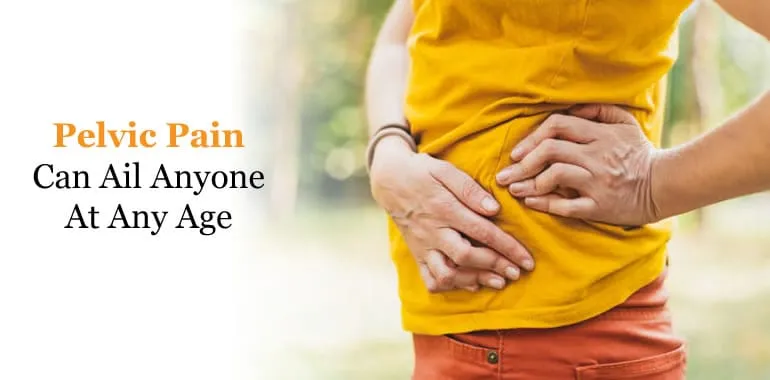Pelvic pain can ail anyone at any age, even those who have not had children. In this article we will discuss three different populations that we see in our clinic with pelvic pain: Pregnant women, postpartum women and women of childbearing years. Let’s go over what is meant when we say “Pelvic Pain”, here’s a little anatomy: The pelvis is shaped like a bowl and the bowl is constructed of two ilia (hemi-pelvis) that come together in the front to form the pubic symphysis (this is a joint and is further held together with ligaments and connective tissue). The pubic symphysis sits in the groin region and the adductor muscles attach to either side of it. The back of the ilia have a sacrum that is wedged between them. The meeting point of the back of the ilia and the sacrum is called the sacroiliac joint (SIJ). The SIJ is still considered part of your “lower back”. Inside of the pelvis we have the bladder, the rectum and the uterus. When women come to see us with complaints of “pelvic pain” we must first determine which part of (sometimes more than one) the pelvis is causing the problem.
Here are some things you may experience that could be considered “pelvic pain” in origin:
Pelvic Pain During Pregnancy
It isn’t difficult to understand why a pregnant woman might suffer with pelvic pain, her abdomen is growing at the same time that her pelvis is expanding in anticipation of the delivery of her little bundle of joy. There are also hormones being released in a gradual manner that send signals to the ligaments surrounding her pelvis to loosen up so that delivery is possible.
Still not all pregnant women experience pelvic pain, some just breeze through their pregnancy without a hitch, while others are in a significant amount of pain for the majority of their pregnancy. When we have a woman come to see us for physical therapy and is pregnant, we must be careful to assess how far along she is in her pregnancy as well as what other co-morbidities she has.
Diagnosis of a Pregnant Woman With Pelvic Pain:
We diagnosis a woman who is pregnant in the same manor that we would anyone else, the only difference is we will not be performing an internal exam of her pelvic floor muscles. The exam however is still extremely thorough and each of the joints of the pelvic are assessed to find out where the culprit of the pain is.
Treatment:
It is very common that we find what’s called an “upslip” of one of the ilia bones, which creates a problem with the SIJ. This is very common and also very easy to fix with a gentle muscle energy technique, some soft tissue massage and home exercises that are specific to the issue. Another common culprit in this population is a symphysis pubis separation. This is where the pubic symphysis is stuck either too high or too low. The causes for this are typically a woman who is carrying very low in her pregnancy, someone who has gained an excessive amount of weight or someone who has had an SIJ problem for some time that they have been ignoring. The treatment is very gentle and effective with the use manual therapy, as well as stability training to the muscles. A belt is often recommended if we find the problem is not stabilizing with the treatments.
Pelvic Pain in the Postpartum Period
We see a number of women who are still experiencing pelvic pain well past the birth of their baby, many for 2+ years after the little one is born. This is undoubtedly a very challenging time for any woman! The new mommy is dealing with her constantly changing body, hormonal shifts, weight fluctuation, sleep deprivation, the pressure to lose the weight, stay active and OH take care of and bond with the baby! It is no wonder why we get so many women who are utterly exhausted and in pain, they have almost no time to care for themselves. In this time period it is just about surviving. The priority is that the baby is well fed and taken care of, not to mention other kids in the family, I won’t even go there right now!
Diagnosis of Postpartum Woman:
During our exam we want to know how long this has gone on for, what has helped, if she has other children and how those pregnancies were, and if she is still breastfeeding. Our exam will initially be orthopedic in nature. We will want to determine if there has been a birth trauma, tearing, etc., if there is an “up-slip” of the ilia bone, a pubic symphysis separation, a lumbar spine misalignment, a problem with the hip joint. The second step is an internal pelvic floor examination. Here we look for any gross weakness of the pelvic floor muscles or tension of the pelvic floor muscles. Either of those problems can cause pain in the hips, lower back, SIJ or pubic symphysis.
Treatment:
Manual therapy is a crucial part of the rehabilitation of the postpartum woman. We will need to do what it takes to re-align the body, with the use of manipulation techniques, muscle energy techniques, soft tissue mobilization, stretching, stability training to the core or pelvic floor muscles, or providing an SI belt for stability while picking up the baby. We will also go over in depth the best way to handle the baby in order to ensure the problem doesn’t worsen, as well as nursing techniques.
Pelvic Pain During Child-Bearing Years
In our practice we see many women between the ages of 20- 40 who have not had children with complaints of pelvic pain. The source of the problem here can be any of the ones we have already discussed: Pubic symphysis (although less likely in this population), SIJ, hip problem or lumbar mis-alignment. With this population we find the cause or triggering event, since it isn’t birth, to be traumatic in nature. The trauma can be due to sexual trauma, physical injury, or even emotional in nature. Any of these can cause an imbalance in the body which will trigger a stress response that can be ongoing. The stress response can cause spasm in the pelvic floor, the diaphragm, the abdominal muscles, the muscles of the lower back, etc. which will in turn create an environment where any little wrong move can push the vertebra or the lower back, the SIJ or the hip joint in a position they do not belong.
Diagnosis:
Here we do need to do the 2 level exam, an internal exam as well as an orthopedic exam. We will also look for poor breathing patterns (which happen without us knowing it because of either the emotional stress or the ongoing pain), muscles firing inappropriately, poor exercise mechanics, postural issues, issues with the feet, etc. The point is the exam is extremely thorough and we typically do not miss anything. *Note we have had many women who prefer not to have an internal exam due to trauma, sexual or other and that is perfectly fine, we can still help!
Treatment:
Manual therapy, muscle energy technique, soft tissue mobilization (internal, external or both), stretching, strengthening, postural education, breathing training, body awareness, self care techniques, nutrition and supplementation advice.
In summary, there are 3 different phases in a woman’s life in which she can experience pelvic pain. I hope I’ve helped you understand the differences between each phase, how and why the diagnosis and treatments would differ and that physical therapy can really save your body during any of these times! A physical therapist who has gone through training to be able to specifically help women during these challenging times is someone you want on your team! My advice to any woman is to seek out a specialist who you feel comfortable enough with to share what you are experiencing and allow us to do the examination and follow up work required for full healing. We have helped thousands of women with these very problems live their lives without pain with intercourse, without pain when carrying the baby, without pain every time they bend down to do chores! If you need help with any of these problems, do not hesitate to get help sooner than later! In a perfect world, every woman should have a pelvic floor specialist examine her after having a baby and determine when she should return to exercise. You really do not have to suffer silently. This is what we do every single day for woman of all ages.
Dedicated to restoring your health,
Dr. Shaden at Universus Physical Therapy and Wellness


